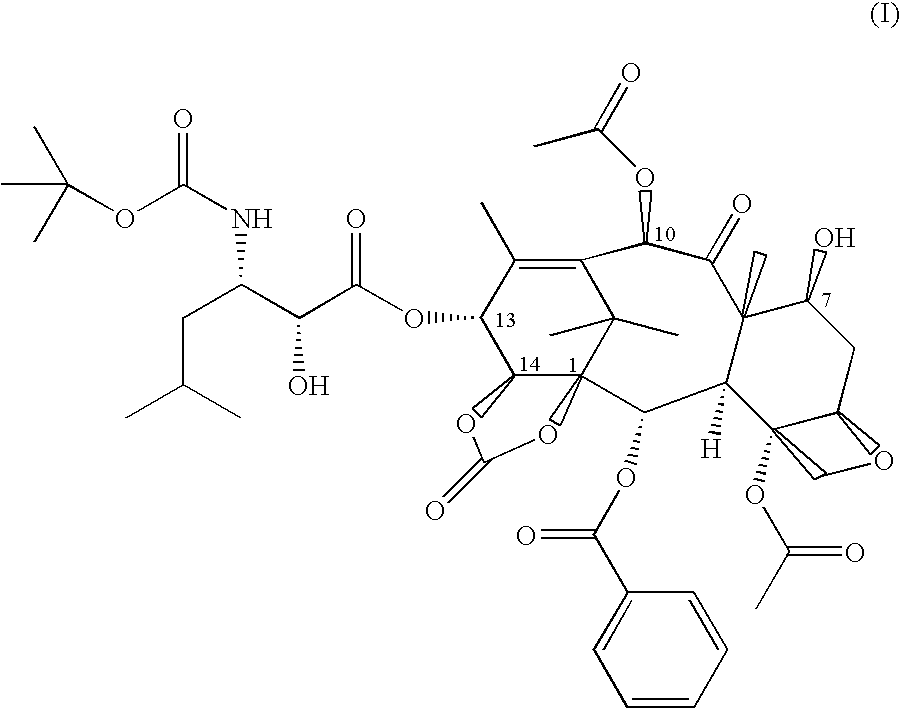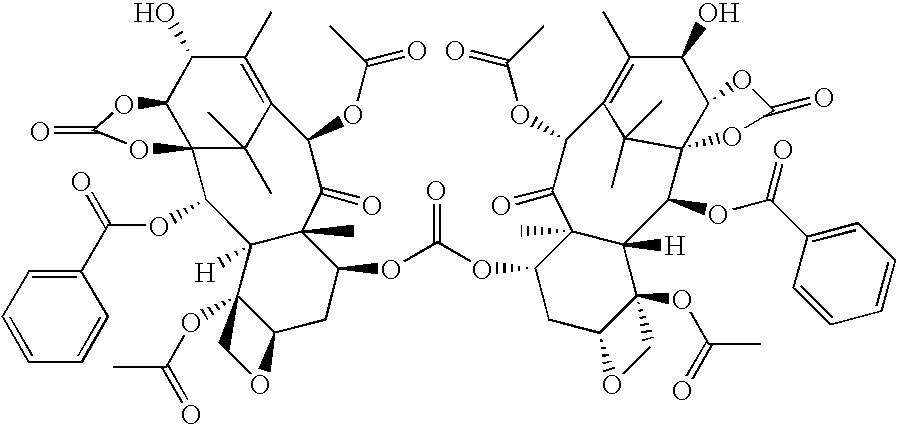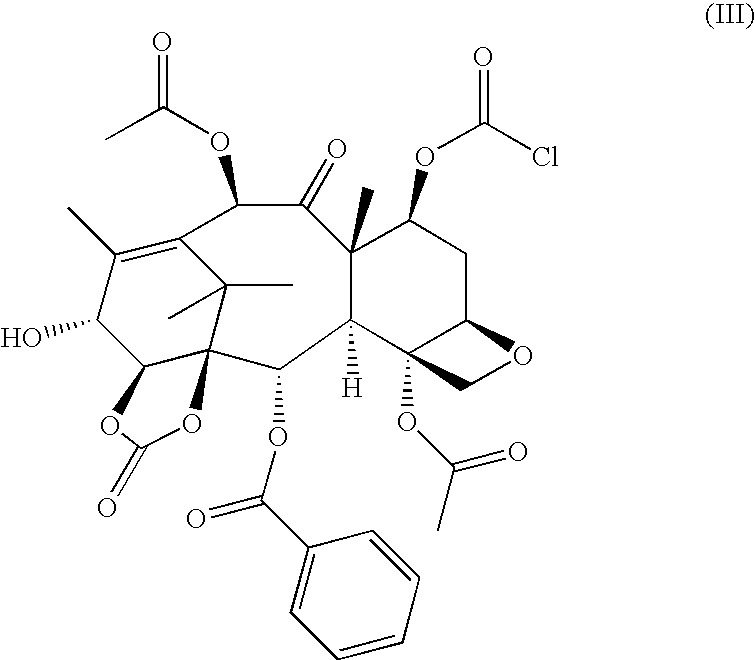Process for the preparation of a taxane derivative
a technology of derivatives and taxane, applied in the field of taxane derivatives, can solve the problems of lowering the yield, troublesome scaling up process b to a multi-kilo scale, and carrying ou
- Summary
- Abstract
- Description
- Claims
- Application Information
AI Technical Summary
Problems solved by technology
Method used
Image
Examples
example 1
14β-Hydroxybaccatin III (V) (step a)
[0044]14β-Hydroxy-10-deacetylbaccatin III (VII) (10 kg) was suspended in THF (45 L) and CeCl3×7H2O (0.5 kg) was added. Acetic anhydride (6.6 kg) was added over 20 minutes and the reaction mixture was stirred at room temperature for 2 hours, then quenched by addition of water (10 L). THF was distilled off under vacuum and the residue was dried until the water content was less than 10%, then crystallized from ethyl acetate to afford the title compound as a white solid (8.2 kg, yield 85%).
[0045]1H-NMR (300 MHz, CDCl3): 1.02 (s, 3H), 1.08 (s, 3H), 1.62 (s, 3H), 1.78 (ddd, 1H), 1.99 (d, 3H), 2.16 (s, 3H), 2.24 (s, 3H), 2.46 (ddd, 1H), 3.43 (OH, s), 3.73 (d, 1H), 3.89 (d, 1H), 4.18 (s, 2H), 4.35 (dd, 1H), 4.60 (dd, 1H), 4.91 (dd, 1H), 5.73 (d, 1H), 6.28 (s, 1H), 7.39 (t, 1H), 7.52 (dt, 2H), 8.06 (d, 2H).
example 2
14β-Hydroxybaccatin III-1,14-carbonate (VI) (step b)
[0046]14β-Hydroxybaccatin III (VIII) (5.0 kg) was dissolved in a mixture of dichloromethane (48.0 L) and pyridine (8.0 kg). The reaction mixture was cooled down to −10° C. and a solution of bis(trichloromethylcarbonate) (5.4 kg) in dichloromethane (32.0 L) was added over 30 minutes. The reaction was quenched by addition of a sodium carbonate solution (11.9 kg) dissolved in water (55.0 L) and the resulting biphasic mixture was stirred for 1 hour, then diluted with water. The phases were separated and the aqueous one was extracted with dichloromethane (23.8 L). The organic phases were pooled and washed with 20% hydrochloric acid (40 L), then with water (30.0 L) and with brine (40 L). Part of the solvent was distilled off under vacuum and the solution of the title compound (VI) was used directly in the next step.
[0047]1H-NMR (300 MHz, CDCl3): 1.24 (s, 3H), 1.28 (s, 3H), 1.56 (OH, s), 1.75 (s, 3H), 1.92 (ddd, 1H), 2.13 (d, 3H), 2.60 (d...
example 3
7-Trichloroacetyl-14-hydroxybaccatin III-1,14 carbonate (VII) (step c)
[0048]The solution from the previous step was added with pyridine (2 L) and cooled down to −10° C. Trichloroacetyl chloride (1.6 kg) was added over 15 minutes maintaining the temperature between −10 and 0° C. The reaction mixture was stirred at the same temperature for 2 hours. The reaction was quenched by addition of a solution of NaHSO4 (2 kg) in water (20 L). The phases were separated and the aqueous one was extracted with dichloromethane (2 L). The combined organic phases were evaporated to small volume and toluene (20 L) was added. The solvent was removed by distillation at atmospheric pressure until the distillation-head reached a temperature of 110° C. On cooling the title compound crystallised as a white solid, which was filtered off and dried under vacuum. (4.96 kg, yield of two steps 85%).
[0049]1H-NMR (300 MHz, CDCl3): 1.20 (s, 3H), 1.28 (s, 3H), 1.93 (s, 3H), 2.03 (ddd, 1H), 2.17 (d, 3H), 2.20 (s, 3H), ...
PUM
| Property | Measurement | Unit |
|---|---|---|
| temperature | aaaaa | aaaaa |
| temperature | aaaaa | aaaaa |
| temperature | aaaaa | aaaaa |
Abstract
Description
Claims
Application Information
 Login to View More
Login to View More - R&D
- Intellectual Property
- Life Sciences
- Materials
- Tech Scout
- Unparalleled Data Quality
- Higher Quality Content
- 60% Fewer Hallucinations
Browse by: Latest US Patents, China's latest patents, Technical Efficacy Thesaurus, Application Domain, Technology Topic, Popular Technical Reports.
© 2025 PatSnap. All rights reserved.Legal|Privacy policy|Modern Slavery Act Transparency Statement|Sitemap|About US| Contact US: help@patsnap.com



